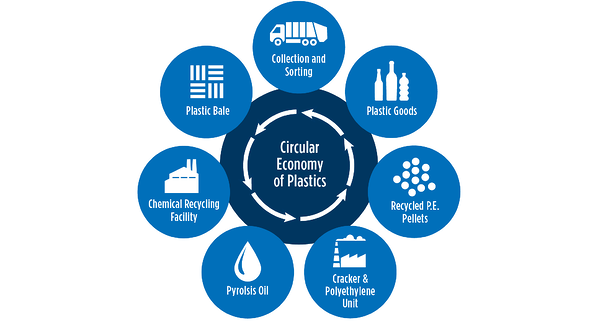Circular polymer and circular economy
In the linear economy, raw natural resources are taken, transformed into products, and disposed of. On the opposite, a circular economy model aims to close the gap between production and natural ecosystems’ cycles, which humans ultimately depend upon. On the one hand, this means eliminating waste – composting biodegradable waste or, if it’s a transformed and non-biodegradable waste, reusing, remanufacturing, and finally recycling it. On the other hand, it also means cutting off chemical substances (a way to help regenerate natural systems) and betting on renewable energy.
Definitions often focus on the use of raw materials or system change. Explanations that focus on resource use usually follow the 3-R approach:
Reduce (minimum use of raw materials)
Reuse (maximum reuse of products and components)
Recycle (high-quality reuse of raw materials)
Why do we need to switch to a circular economy?
The world’s population is growing, and with it, the demand for raw materials. However, the supply of crucial raw materials is limited.
Finite supplies also mean some EU countries are dependent on other countries for their raw materials.
In addition, extracting and using raw materials has a significant impact on the environment. It also increases energy consumption and CO2 emissions. However, more intelligent use of natural materials can lower CO2 emissions.
Plastics represent the main product of the chemical industry on a mass basis. The annual production of plastic materials, which amounted to 70 million tons in 2020 in Europe, is expected to increase in the short and midterm. Given their versatility, polyolefins are the most used plastics. Among them, polyethylene (PE) is at present the most widely demanded plastic, representing 30% of the total production when all its varieties are considered: high, medium, low, and linear low-density polyethylene. The primary use of PE is packaging in the form of films, bottles, or bags, which are often single-use and result in thousands of tons of plastic waste. According to statistics on waste management in Europe, during 2015, 72% of plastic packaging was not recovered at all, 40% of which was sent to landfills, while the other 32% was mismanaged.
Circular Polymers
The Circulen product portfolio includes:
Circulen Recover polymers are made from plastic waste through a mechanical recycling process;
Circulen Revive polymers are made using an advanced (molecular) recycling process to convert plastic waste into feedstock to produce new polymers, which have a wide range of uses;
Circulen Renew polymers are made from renewable feedstocks such as used cooking oil, which have many uses.
Circular polyethylene
Circulen Recover
Recovering plastic waste from the environment (both pre and post-consumer waste)
Circulen Recover polymers are made from a mechanical recycling process to produce recycled resins. By processing the plastic waste through the shortest recycling loop, a lower carbon footprint can be achieved.
Historically, recycled polymers have been associated with low-end applications and were often less durable or lower in quality. Circulen Recover polymers offer a consistent, high-quality product containing recycled material that can be used in several applications, such as consumer rigid packaging and caps and closures.
Circulen Revive
Using advanced (molecular) recycling technology
Circulen Revive polymers are on their way to becoming one of the solutions that can address at scale the challenge of hard-to-recycle plastics. Circulen Revive polymers support taking plastic waste that is not quickly recovered by mechanical recycling and converting it into a feedstock to produce new polymers. This allows more significant volumes of plastic waste to return to the value chain as high-quality polymers while accomplishing a lower CO2 footprint.
Circulen Renew
With renewable-based raw materials, such as used cooking oil, as a feedstock.
Circulen Renew polymers offer a variety of polypropylene (PP) and polyethylene (HDPE and LDPE) grades equivalent to virgin resin quality while reducing fossil feedstock use and helping to reduce CO2 over the product life cycle. These renewable-based polymers offer the same properties in terms of product performance as well as regulatory approvals. This makes these new grades a perfect drop-in solution for applications like food packaging and high-quality requirement films such as surface protection films.



 Vacuum Packaging
Vacuum Packaging
Leave a Reply
Want to join the discussion?Feel free to contribute!